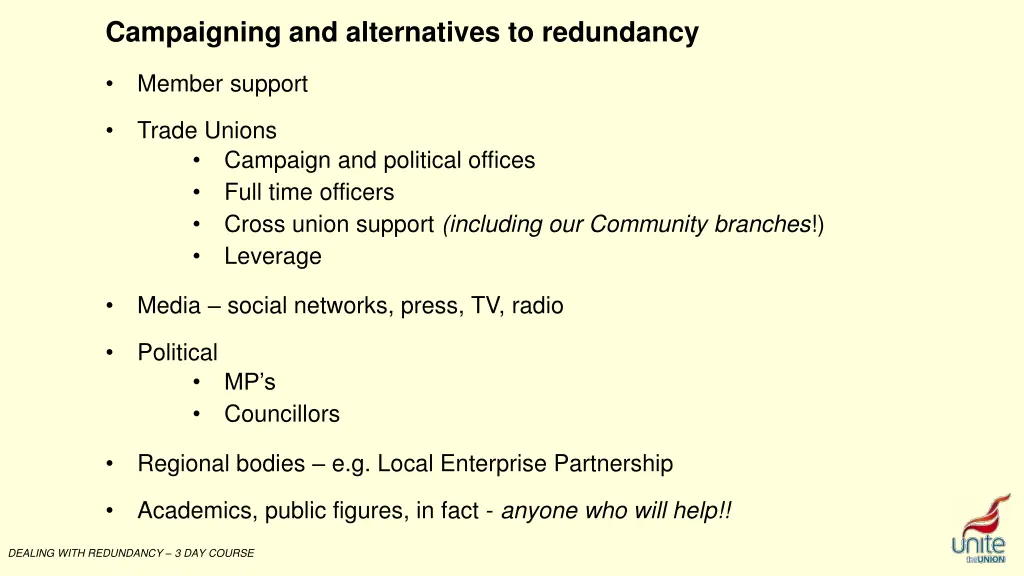
Effective Strategies for Avoiding Redundancies in the Workplace
Discover alternative approaches to redundancy such as member support, trade unions, political advocacy, and job alternatives like redeployment and reskilling. Learn how to navigate contract revisions and industrial action in dealing with redundancy situations.
Download Presentation

Please find below an Image/Link to download the presentation.
The content on the website is provided AS IS for your information and personal use only. It may not be sold, licensed, or shared on other websites without obtaining consent from the author. If you encounter any issues during the download, it is possible that the publisher has removed the file from their server.
You are allowed to download the files provided on this website for personal or commercial use, subject to the condition that they are used lawfully. All files are the property of their respective owners.
The content on the website is provided AS IS for your information and personal use only. It may not be sold, licensed, or shared on other websites without obtaining consent from the author.
E N D
Presentation Transcript
Campaigning and alternatives to redundancy Member support Trade Unions Campaign and political offices Full time officers Cross union support (including our Community branches!) Leverage Media social networks, press, TV, radio Political MP s Councillors Regional bodies e.g. Local Enterprise Partnership Academics, public figures, in fact - anyone who will help!! DEALING WITH REDUNDANCY 3 DAY COURSE
Campaigning and alternatives to redundancy Alternatives Reduce overtime Removal of sub contract and/or temporary labour Review shift working arrangements Consider natural attrition / recruitment controls Transfer sub contracted work back in Secondment to parts of the organisation that are unaffected Internal retraining Redeployment Relocation Pay freeze / cut Revised contract of employment DEALING WITH REDUNDANCY 3 DAY COURSE
Campaigning and alternatives to redundancy Revised / new contract of employment A contract can only be varied by mutual agreement However if you reject the new contract and the employer imposes the new one it is not automatically unfair Continuing to work without agreement to the new terms may imply your acceptance They may dismiss you then offer new terms providing they follow the correct process for dismissal Registering your refusal of the new terms and working under protest may constitute industrial action DEALING WITH REDUNDANCY 3 DAY COURSE
Alternative work To help mitigate jobs we can look at: Redeployment into a suitable alternative job considering: how similar the work is to your current job the terms of the job being offered your skills, abilities and circumstances in relation to the job the pay (including benefits), status, hours and location trial period Relocation with your existing job or in an alternative role Secondment to an unaffected area of the organisation Reskilling / retraining for internal roles DEALING WITH REDUNDANCY 3 DAY COURSE
Alternative work What is reasonable alternative employment ? Your employer can offer you an alternative job in any way, but unless they follow the rules you can refuse it and get your redundancy pay instead. Your employer has to: offer you the new job in writing or orally make the offer before your current job ends make sure the new job starts within 4 weeks of your current job ending give you enough detail about the job to understand what you d be doing and how it would be different to your current job DEALING WITH REDUNDANCY 3 DAY COURSE
Alternative work Trying out alternative jobs You can spend 4 weeks trying out any alternative job you re offered. If your employer offers you several alternative jobs you can try each one for 4 weeks. Your trial period could start up to 4 weeks after your current job ends. No matter when your trial period starts, you ll still get 4 weeks to try the alternative job. Your trial period still only lasts 4 weeks if you re ill or on holiday for part of it. You and your employer can agree to extend your trial period if you need training for the job. Make sure you get your employer s agreement in writing, with a clear end date. Your redundancy might be unfair if your employer doesn t let you try the job before deciding whether to take it. DEALING WITH REDUNDANCY 3 DAY COURSE
Alternative work If you don t want to take an alternative job Inform your employer in writing and check that you ll get your redundancy pay instead. To get your redundancy pay, you ll also need to: refuse the alternative job before your current job ends, or before the end of the alternative job s 4-week trial give a good reason for refusing your new job A good reason could be about the job itself or about your personal situation e.g. disruption to your family life, for example, problems with childcare longer journey to work or lack of public transport extra costs of getting to work health issues lower pay DEALING WITH REDUNDANCY 3 DAY COURSE
Support What might support look like? Financial Education Interview skills CV writing Retraining Outplacement centre/provider Time off to look for work DEALING WITH REDUNDANCY 3 DAY COURSE
ACTIVITY 5 CAMPAIGNING Using your workbooks, work as a group to discuss the tasks DEALING WITH REDUNDANCY 3 DAY COURSE



